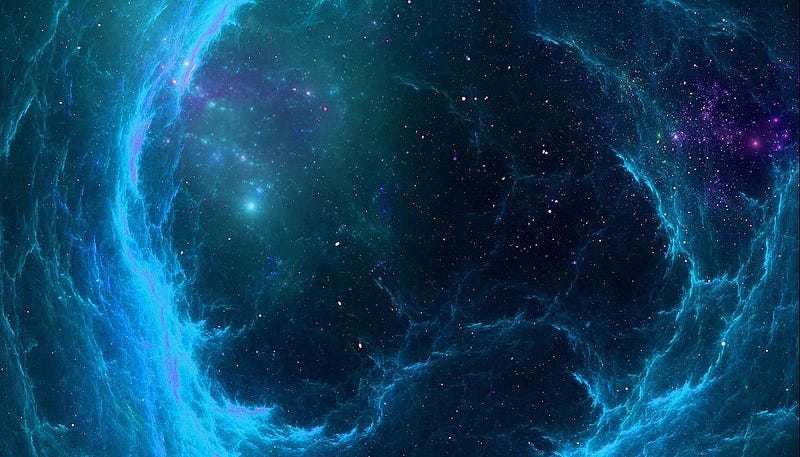Exploring the Hidden Realm of Dark Matter Surrounding Black Holes
Written on
Chapter 1: The Enigma of Dark Matter
Recent indirect evidence suggests that there may be a dense presence of dark matter surrounding black holes, which is crucial for upcoming research endeavors.

Dark matter remains one of the greatest mysteries in modern physics, widely accepted yet controversial due to its elusive nature. The observational data supporting dark matter is sparse and often derived from infrequent astronomical events, leaving the search for a definitive candidate ongoing.
One pivotal moment in dark matter research came from the observation of two galaxy clusters colliding approximately 150 million years ago, reported in August 2006. This incident provided more substantial proof of dark matter's existence.
However, the discrepancies between what is visible and what is observed lead some skeptics to propose alternative explanations, adjusting existing formulas and calculations rather than acknowledging dark matter's existence. It’s a challenging position, as those who oppose the prevailing theories often struggle to publish their findings in reputable journals and face difficulties securing funding.
The postmodern scientific expectation is that phenomena like dark matter and dark energy should exist, suggesting that uncertainty and the unknowable are inherent in our universe. Returning to the core topic, dark matter is characterized by its inability to emit or reflect light or interact with electromagnetic forces, complicating detection efforts.
Section 1.1: Indirect Indicators of Dark Matter
Several inconsistencies hint at the presence of dark matter:
- Galactic rotation curves
- Mass deficits in galaxy clusters
- Temperature distributions of hot gases in galaxies
- Velocities of objects moving away from galaxy centers
These anomalies imply that there is significantly more matter in galaxies and the universe than is observable, although they do not constitute definitive proof of dark matter.
Detection methods to investigate dark matter include:
- Gamma-ray observations
- Collisions between galaxies
- Rare astronomical events like black hole mergers
Despite these insights, overwhelming astrophysical phenomena alone do not guarantee a conclusive affirmation of dark matter's presence. Often, discrepancies in calculations lead scientists to hypothesize about dark matter as a means to reconcile these inconsistencies.
Numerous dark matter candidates have been proposed throughout the years, yet clarity remains elusive. Potential candidates include:
- Axions
- Sterile neutrinos
- Neutralinos
- Weakly Interacting Massive Particles (WIMPs)
- Gravitationally-interacting massive particles (GIMPs)
- Supersymmetric particles
- Gravitinos
- Geons
- Dark photons
- Black holes
In light of these challenges, researchers continue to investigate dark matter by anticipating rare observable events.
Section 1.2: Groundbreaking Research on Dark Matter
A recent study led by a team from the Hong Kong University of Education (EdUHK) presents a significant new direction for dark matter research. This team focused on two nearby binary systems (A0620–00 and XTE J1118+480) containing black holes.
The results indicated that the orbital decay rates of the companion stars were around one millisecond (1 ms) per year—substantially higher than the theoretical expectation of 0.02 ms per year. Dr. Chan Man-ho noted that such high densities of dark matter could create dynamic friction akin to drag force on the companion stars.
The researchers utilized a 'dark matter dynamical friction model' in their simulations, making this the first study to apply this model to substantiate the existence of dark matter surrounding black holes. The data was remarkably consistent, with the observed orbital distortions of the companion stars aligning perfectly with the predictions, providing indirect evidence of dense dark matter around black holes.
The video titled "Do black holes contain dark matter?" discusses the ongoing exploration of dark matter's role in black hole physics, shedding light on this fascinating topic.
In the video "Are Black Holes the source of Dark Energy? – with Dr Chris Pearson," experts explore the potential connections between black holes and dark energy, further enriching our understanding of cosmic phenomena.
For more insights, consider subscribing to my newsletter for updates.
Are you new to Medium? Sign up with my referral link for unlimited access to all stories on Medium.
Explore every article from Sarp and thousands of other writers on Medium with full access to all content.
Reference
Man Ho Chan and Chak Man Lee. "Indirect Evidence for Dark Matter Density Spikes around Stellar-mass Black Holes." The Astrophysical Journal Letters. DOI: 10.3847/2041–8213/acaafa